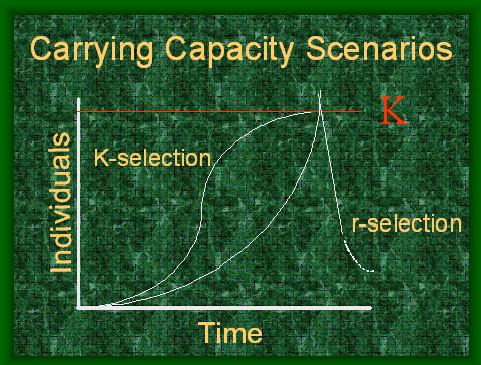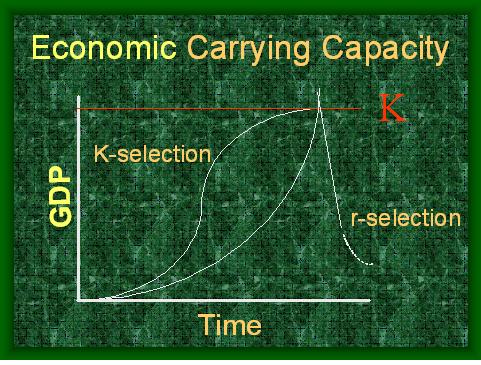Carrying Capacity
Basic Biology
One of the earliest concepts related to the issue of scale is that of carrying capacity1. Biologists define carrying capacity as the maximum population of a given species that can survive indefinitely in a given environment. It was originally applied to relatively simple population-environments such as the number of sheep or cattle that could be maintained  on grazing land without degrading the land so that it could no longer support the animals. It depends on the conditions and resources available in the specific area, and the consumption habits of the species considered. Because both what is available in the area, and the consumption habits of the species change over time, carrying capacity is always changing. Carrying capacity is a measure of sustainability within these changing conditions.
on grazing land without degrading the land so that it could no longer support the animals. It depends on the conditions and resources available in the specific area, and the consumption habits of the species considered. Because both what is available in the area, and the consumption habits of the species change over time, carrying capacity is always changing. Carrying capacity is a measure of sustainability within these changing conditions.
Two Patterns
Many animal species have been studied with respect to a specific area’s carrying capacity. Starting from a low population level there are two quite different patterns which describe how various species reach carrying capacity, the sigmoid and peak phenomena. Populations which exhibit the sigmoid pattern increase rapidly while food and habitat are abundant, and then slow down as regulatory factors such as lower birth rate and reduced food availability come into play. As the rate of population growth slows down to zero, the population reaches a fairly stable level. This pattern is referred to as K (for constant) selected species.
The other pattern of reaching carrying capacity is similar in the early stages when the population is still small. But in this situation the same regulatory factors do not come into play and the population increases rapidly to the point where it exhausts the resources upon which it depends. At this point, mortality becomes the primary regulatory factor, and the population collapses to a low level. When resources are replenished the population begins to rise again; this process is repeated in a boom and bust cycle. This is referred to as the “r-selected” species.
Human Application
The concept of carrying capacity was applied to human populations in the 1960’s. It was noted that the consumption habits of humans are much more variable than those of other animal species, making it considerably more difficult to predict the carrying capacity of the earth for human beings. This realization gave rise to The IPAT Equation which pointed out that carrying capacity for humans was a function not only of population size, but also of differing levels of consumption, which in turn are affected by the technologies involved in production and consumption.
There have been a large number of published estimates for the human carrying capacity of the earth; they range from a low of one half billion people to a staggering 800 billion. Many of these estimates are more ideologically based than determined by scientific principles2. These exercises demonstrate the complexity of developing useful estimates of the human carrying capacity of the planet, and the limitations of using the methodology which has been successful with non-human species.
Various estimates of human carrying capacity also demonstrate in a general way the relationships among some of the major factors involved. Obviously, if consumptions levels per capita are higher, then a smaller population can be supported. If technologies increase or decrease overall consumption, then they also affect carrying capacity. Because the idea and  methodology of carrying capacity were developed in the natural science of biology, they incorporate the notion of limits imposed by the earth’s natural systems. Species can overshoot these limits (as with the r-selected species), and when they do, they collapse and risk extinction.
methodology of carrying capacity were developed in the natural science of biology, they incorporate the notion of limits imposed by the earth’s natural systems. Species can overshoot these limits (as with the r-selected species), and when they do, they collapse and risk extinction.
The big question for human civilization raised by this application of carrying capacity to the human population is whether we will be a K or r-selected species; whether we will reach a stable level that can be sustained for an indefinite period; or whether we will grow to a peak and collapse. Biological studies of various species provide us with some basic lessons to apply to the human condition, but new ideas and methodologies are needed to incorporate the added complexities of human technologies and culture. But carrying capacity tells us that the biophysical limits of our environment are key in determining how many human can survive at what levels of consumption3.
Relation to Sustainable Scale
The concept of carrying capacity is well rooted in biological science, and describes the rise and decline of plant and animal populations. It clarifies that there is a limit to the growth of any biological population, and identifies some of the parameters that determine the pattern of population rise and collapse. Additional layers of complexity occur for the human population in terms of the dynamics involved. Human choices are needed to ensure we imitate a K rather than an r-selected species.
"…carrying capacity is determined jointly by human choices and natural constraints. Consequently, the question, how many people can the Earth support, does not have a single numerical answer, now or ever. Human choices about the Earth's human carrying capacity are constrained by facts of nature which we understand poorly. So any estimates of human carrying capacity are only conditional on future human choices and natural events." Joel Cohen
References
1 Nebel, B.J., and R.T. Wright. Environmental Science: The Way the World Works. Seventh Edition. Prentice Hall, New Jersey, 2000.
2Cohen, Joel. How Many People Can the Earth Support? New York: W. W. Norton, 1995.
Pulliam, H.R., and N.M. Haddad. Human population growth and the carrying capactiy concept. Bulletin of the Ecological Society of America, 1994, 75: 141-157.
3 Czech, B. Shoveling Fuel for a Runaway Train: Errant Economists, Shameful Spenders, and a Plan to Stop Them All. University of California Press, 2000, pgs 88-92.